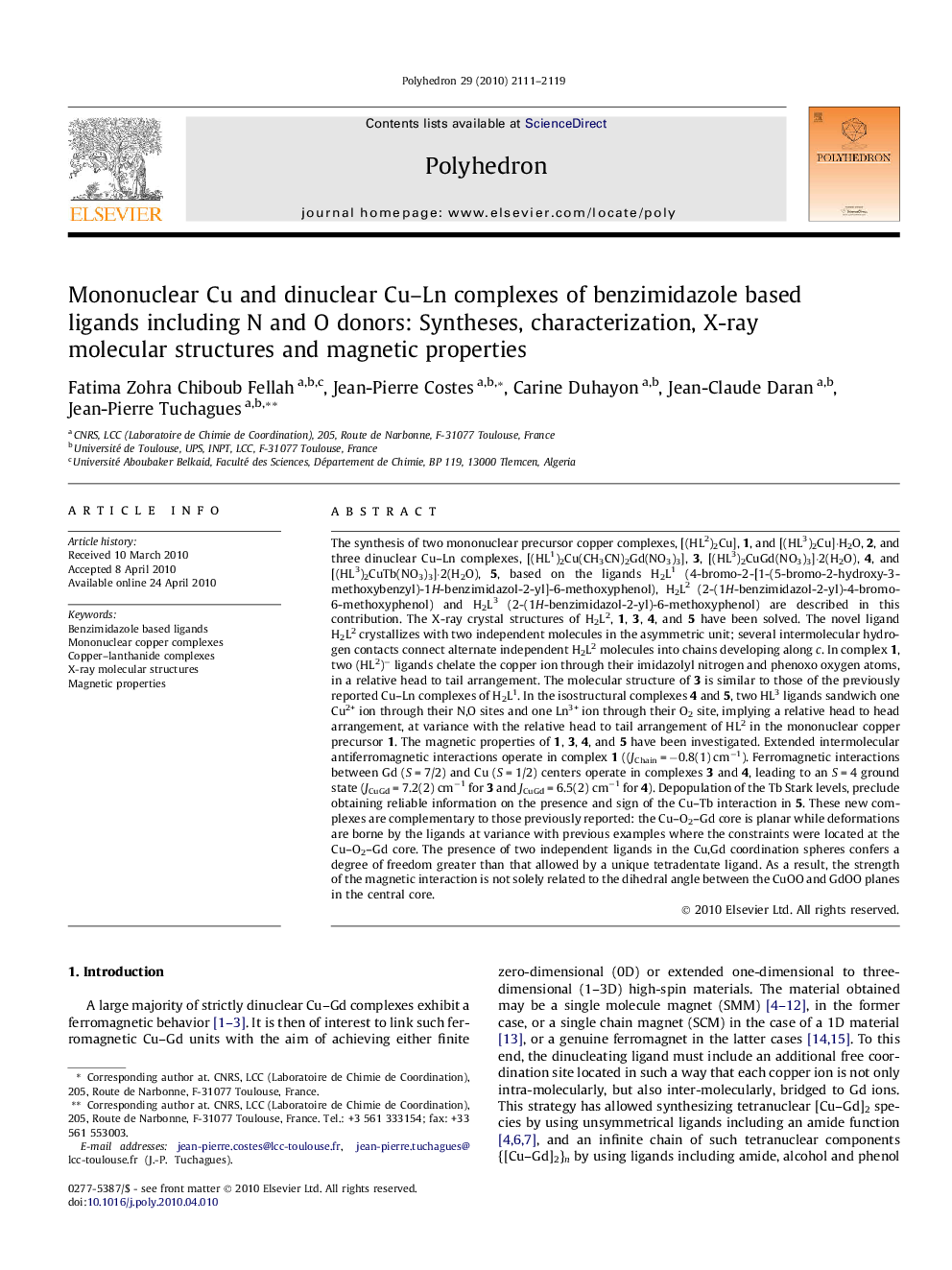| کد مقاله | کد نشریه | سال انتشار | مقاله انگلیسی | نسخه تمام متن |
|---|---|---|---|---|
| 1338992 | 979687 | 2010 | 9 صفحه PDF | دانلود رایگان |

The synthesis of two mononuclear precursor copper complexes, [(HL2)2Cu], 1, and [(HL3)2Cu]·H2O, 2, and three dinuclear Cu–Ln complexes, [(HL1)2Cu(CH3CN)2Gd(NO3)3], 3, [(HL3)2CuGd(NO3)3]·2(H2O), 4, and [(HL3)2CuTb(NO3)3]·2(H2O), 5, based on the ligands H2L1 (4-bromo-2-[1-(5-bromo-2-hydroxy-3-methoxybenzyl)-1H-benzimidazol-2-yl]-6-methoxyphenol), H2L2 (2-(1H-benzimidazol-2-yl)-4-bromo-6-methoxyphenol) and H2L3 (2-(1H-benzimidazol-2-yl)-6-methoxyphenol) are described in this contribution. The X-ray crystal structures of H2L2, 1, 3, 4, and 5 have been solved. The novel ligand H2L2 crystallizes with two independent molecules in the asymmetric unit; several intermolecular hydrogen contacts connect alternate independent H2L2 molecules into chains developing along c. In complex 1, two (HL2)− ligands chelate the copper ion through their imidazolyl nitrogen and phenoxo oxygen atoms, in a relative head to tail arrangement. The molecular structure of 3 is similar to those of the previously reported Cu–Ln complexes of H2L1. In the isostructural complexes 4 and 5, two HL3 ligands sandwich one Cu2+ ion through their N,O sites and one Ln3+ ion through their O2 site, implying a relative head to head arrangement, at variance with the relative head to tail arrangement of HL2 in the mononuclear copper precursor 1. The magnetic properties of 1, 3, 4, and 5 have been investigated. Extended intermolecular antiferromagnetic interactions operate in complex 1 ((JChain = −0.8(1) cm−1). Ferromagnetic interactions between Gd (S = 7/2) and Cu (S = 1/2) centers operate in complexes 3 and 4, leading to an S = 4 ground state (JCuGd = 7.2(2) cm−1 for 3 and JCuGd = 6.5(2) cm−1 for 4). Depopulation of the Tb Stark levels, preclude obtaining reliable information on the presence and sign of the Cu–Tb interaction in 5. These new complexes are complementary to those previously reported: the Cu–O2–Gd core is planar while deformations are borne by the ligands at variance with previous examples where the constraints were located at the Cu–O2–Gd core. The presence of two independent ligands in the Cu,Gd coordination spheres confers a degree of freedom greater than that allowed by a unique tetradentate ligand. As a result, the strength of the magnetic interaction is not solely related to the dihedral angle between the CuOO and GdOO planes in the central core.
Benzimidazole ligands 2-substituted by phenoxy rings bearing methoxy groups coordinate copper in head to tail arrangement; subsequent reaction with lanthanides yield heterodinuclear Cu–Ln complexes through head to head rearrangement of the ligands. The strength of the Cu–Gd ferromagnetic interactions is not related to the sole dihedral angle between the CuOO and GdOO planes.Figure optionsDownload as PowerPoint slide
Journal: Polyhedron - Volume 29, Issue 9, 21 June 2010, Pages 2111–2119